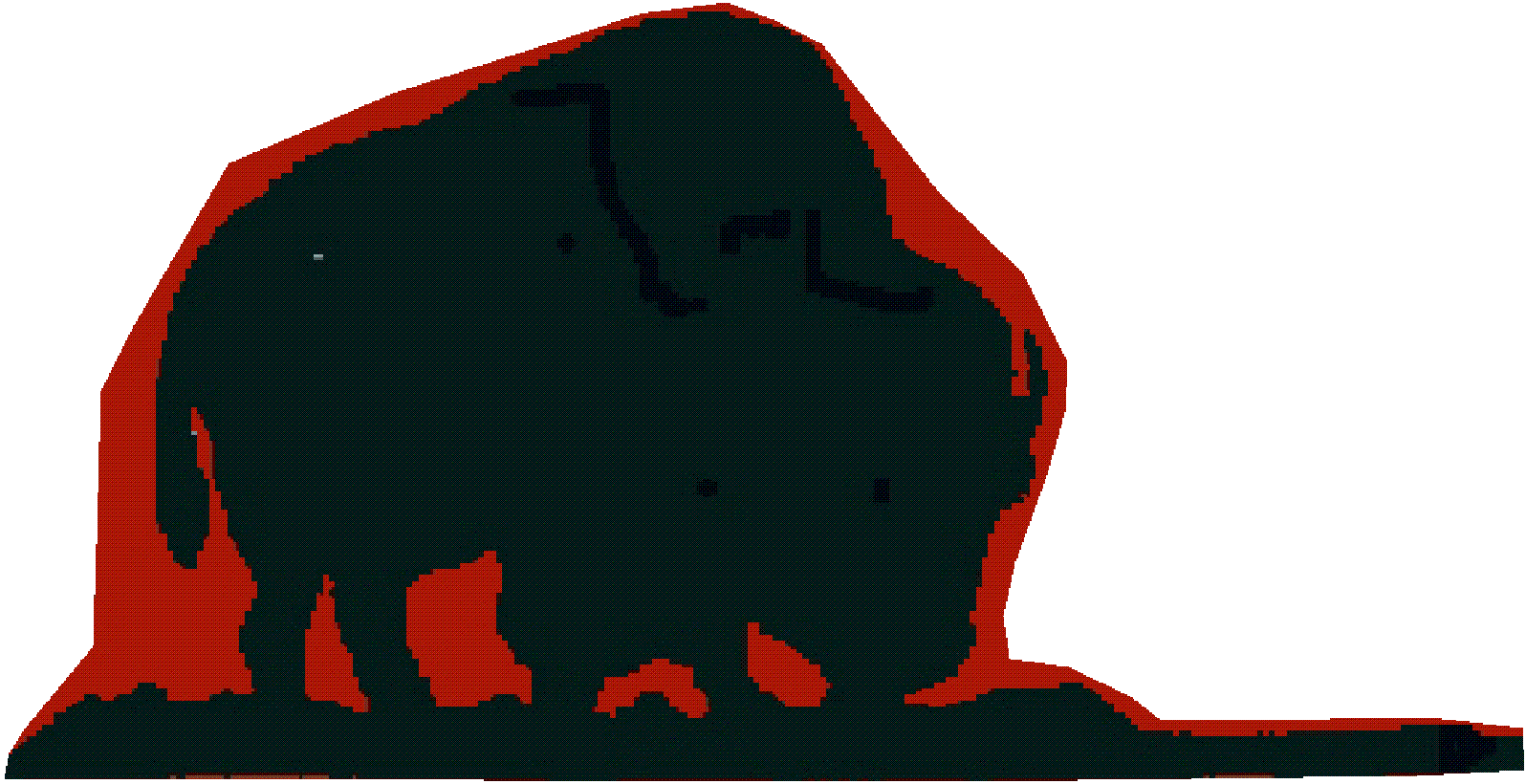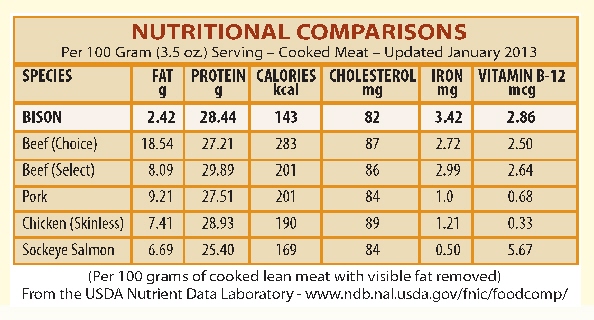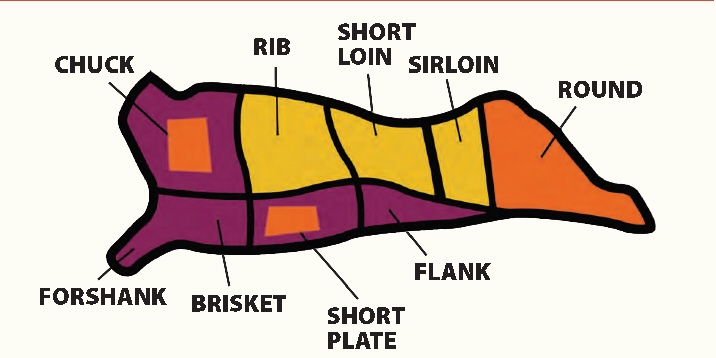Bison Nutritional Information
Grilled New York Strip Bison with Mild Chile Rub
Ancho and Guajillo chile powder off a great Mexican style flavor without the heat. Try other chili powders such as Arbol if you like it hotter. For flavor profiles and to purchase chili powder products visit Bulk Foods
Ingredients:
4 12 ounce New York strip steaks 2 teaspoons garlic powder
4 tablespoons olive oil 1/2 teaspoon cumin
2 tablespoons smoked paprika 1/2 tablespoon kosher salt
2 tablespoons Guajillo powder 1/2 tablespoon freshly ground pepper
Directions:
To make the chile rub, combine all the dry ingredients in a small bowl.
Liberally sprinkle the rub on both sides of the steaks, massaging into the meat. Wrap the steak tightly in plastic wrap and refrigerate for at least two hours or up to 24 hours. Remove the steaks from the refrigerator 1/2 hour to 1 hour before grilling.
When ready to grill, preheat the grill to medium-high. Remove the plastic wrap, rub a small amount of oil on both sides of the steaks.
Lightly oil the grate before putting the steaks on it.
Grill the steaks about 4 minutes per side for medium-rare.
7 Reasons to Choose Bison
By Marilyn Bay Wentz
1 Taste
It all comes down to taste. If food doesn’t taste good, it is difficult to get excited about eating it. Bison is not only good for myriad reasons that follow it, it tastes great. Some say it is sweeter than other meat. It is lean and flavorful.
2 Nutrition
A 3 ounce serving of roasted bison has 143 calories, 28.4 g of protein and 2.4 g of fat, including just 0.9 grams of saturated fat, and more than half the daily recommendation of iron. For those sustained by a 2000 calorie per day diet, this 3 ounce piece of bison provides 48% of daily recommended protein, 3% of total fat and 4% of saturated fat.
Bison also is high in the B complex of vitamins, containing 14% of daily recommended riboflavin, 16% of niacin, 17% of vitamin B-6 and 41% of vitamin B-12. Among other things, B vitamins support healthy eyes, hair and skin. They also helped turn food into energy and ensure healthy liver and nervous system functions.
A serving of bison provides 18% of phosphorus, 21% of zinc and 43% of selenium. Iron is essential in forming the red blood cells that bring oxygen throughout the body. Phosphorus helps form strong bones. Zinc is necessary for the exercise of the senses of smell and taste, and so let him is essential to forming DNA and preventing cell damage from free radicals.
3. Good for the Environment.
Bison are foragers. As they move throughout their pastures, they eat grasses, as well as weeds and noxious plants that other species leave behind. As they graze, their cloven hooves spread seed and their urine and the manure enrich the soil.
4. Natural
The National Bison Association Code of Ethics prohibits members from administering sub- therapeutic antibiotics (antibiotics only intended to stimulate more rapid growth) or other growth promotants to bison.
5. Supports Family Ranchers
Buying bison meat supports the family ranchers who raised them. Buying bison meat also creates demand, which encourages producers to continue raising bison. This demand will ensure bison will never again be threatened with extinction. Today, bison in North America number more than 450,000, despite having dropped to an estimated 1000 total animals around 1900.
6. Readily Available
While bison meat was once difficult to find in grocery stores, today even many supermarkets carry a selection of bison cuts. In addition, consumers have the option of buying bison directly from ranchers, either from a ranch store or at a farmers market. The National Bison Association has members in all 50 states. To find a farm or other meat source near you, visit www.bisoncentral.com or download the free Bison Finder App. from Google Play Store, or the Apple Store.
7. Versatile
As the recipes in this brochure demonstrate, bison is versatile. Bison burgers are easy and wildly popular at backyard barbecues. Roast can be prepared in an oven or slow cooked all day with broth and vegetables for that end of the day family dinner. Steaks are great on the grill for special occasions. A favorite of late is buffalo jerky; it packs a whammy of nutrition and taste in a small, flavorful snack!
Bison is Nutritionally Superior
Bison is much lower in fat and calories than other meats, including chicken and salmon. Unlike other meats, all bison is raised naturally, without hormones or sub therapeutic antibiotics.
Cooking Bison Meat
The Basics
Bison or buffalo meat is similar to beef and is cooked in much the same way. The taste is often indistinguishable from beef, although bison tends to have a fuller, richer (sweeter) flavor. It is not “gamey” or wild tasting. Expect bison meat to be darker red than beef. Bison is very low in fat and cholesterol, and is high in protein, vitamins and minerals.
The leanness ensures that bison meat will cook faster. Fat acts as the insulator – heat must first penetrate this insulation before the cooking process begins. Marbling (fat within the muscle) aids in slowing down the cooking process. Since buffalo meat lacks marbling, the meat will cook more rapidly. Caution must be taken to ensure NOT OVER-COOKING bison.
Preparing Bison Meat
Prepare and bison meat is comparable to preparing other lean meats. Food safety techniques should be followed. Wash hands with soap and water before and after handling raw bison meat. You separate cooking utensils and plates for raw and cooked bison meat.
Bison meat can be cooked much like lean beef but generally is cooked at a lower temperature for a longer time than typical cuts of beef. Since bison is lower in fat than other red meats, it is easier to overcook. Ground bison meat should be cooked to an internal temperature of at least 160°F and the juices should be clear, not red. Roast in steaks should be cooked to an internal temperature of 145°F (medium rare) or 160°F (medium). The oven should be set at around 275°F. After cooking, eat the meat within 3 to 4 days, storing in a refrigerator. For best quality, cook ground bison within two days of purchase, and steaks and roast within 3 to 5 days; otherwise, the meat should be frozen for future use. Bison meat can be kept in the freezer for one year if properly packaged, double paper wrapped or vacuum sealed. If using zip top freezer bags, bison can be stored for three months. Bison meat can be substituted for beef in recipes. The National Bison Association has additional cooking tips and recipes available on its website: www.bisoncentral.com.
Replace Beef With Bison in Your favorite Recipes and Follow These Guidelines:
When oven broiling move your broiler rack away from the heat about a notch lower than where you normally broiled beef steaks. Expect a buffalo steak to cook one third faster than a beefsteak. Bison steaks are best when cooked rare to medium to maintain the moisture and flavor of the meat. It is not recommended to cook buffalo meat past medium. However, if you prefer your state to this degree of doneness, be aware that your buffalo steak may lose some of its desirable attributes.
If you normally cook roast beef at 325°F, turn your oven temperature down to around 275 Fahrenheit four bison. Plan on the roast being done in about the same amount of time as with a comparable size beef roast. To ensure the temperature you prefer, we recommend using a meat thermometer indicated the internal temperature. Again, where to medium rare is recommended.
Ground bison is also leaner (ranging from 90 to 95% lean). It will cook faster so precautions must be taken to not dry out that meat by overcooking it. There is little shrinkage with bison burger-what you put in the pan raw will be close to the same amount after you cook it. Pre-formed patties tend to dry out just a little faster when grilling. (Hint: the thicker the patty, the juicier the burger). Medium-rare to medium is best. Although ground buffalo meat is leaner, there is no need to add that to keep it from sticking to the pan or falling apart.
BEST COOKING METHOD FOR PRICE CUTS
Gold - Most Tender
Tenderloin, Strip Loin, Rib and Ribeye, Top Sirloin
Cooking. Method: dry heat
Orange – Medium Tender
Back Ribs, Bottom Sirloin, Sirloin Top, Top Round, Bottom Round, Eye of Round, Skirt.
Cooking Method: combination of dry in moist heat
Purple – Less Tender
Chuck, Brisket, Flank, Shoulder Clod, Short Ribs, Stew Meat.
Cooking Method: moist heat
Broiling/Grilling: Steaks from the Tenderloin, Rib, Short Loin, Sirloin and Ground Meat. Start with a hot grill, cook hot and fast.
Brasing: Roasts cut from the Round, Foreshank, Chuck or Flank. Moist heat cooking, using larger amounts of liquid and low heat.
Pan Frying: Cubed or marinated steaks.
Marinating: Cubed meat or roast that are not from the Rib or Loin
Cooking in Liquid: Foreshank, Brisket, Chuck, and cuts with little meat and a lot of bone. (Back, Ribs, Short Ribs).





